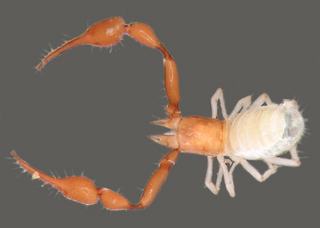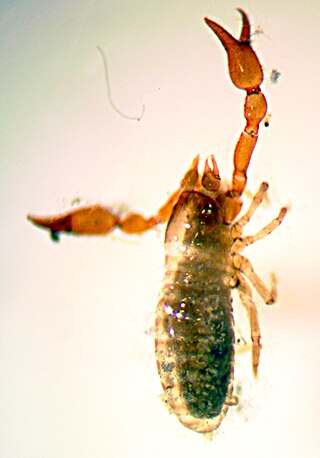
Arachnids are arthropods in the class Arachnida of the subphylum Chelicerata. Arachnida includes, among others, spiders, scorpions, ticks, mites, pseudoscorpions, harvestmen, camel spiders, whip spiders and vinegaroons.

Pseudoscorpions, also known as false scorpions or book scorpions, are small, scorpion-like arachnids belonging to the order Pseudoscorpiones, also known as Pseudoscorpionida or Chelonethida.

The chelicerae are the mouthparts of the subphylum Chelicerata, an arthropod group that includes arachnids, horseshoe crabs, and sea spiders. Commonly referred to as "jaws", chelicerae may be shaped as either articulated fangs, or as a type of pincers. Some chelicerae, such as those found on nearly all spiders, are hollow and contain venom glands, used to inject venom into prey or a perceived threat. Both pseudoscorpions and harvestmen have additional structures on their chelicerae that are used for grooming. In Paratrechalea, males and females have shown to have a chelicerae dimorphism, because the chelicerae is used as a mating signal for females.

The Chthonioidea are a superfamily of pseudoscorpions, representing the earliest diverging and most primitive living pseudoscorpions. The superfamily contains two families.
Mus mayori is a species of rodent in the genus Mus, the mice. Its common names include Mayor's mouse, highland rat, and spiny mouse. It is endemic to Sri Lanka.

Dromopoda is a proposed subclass of the arachnids, including the Opiliones (harvestmen), Scorpions, Pseudoscorpions and Solifugae. The latter three are sometimes grouped as Novogenuata. Combined morphological and molecular analyses have shown Dromopoda to be monophyletic. However, a strictly molecular analysis did not support the monophyly of Dromopoda.

Joseph Conrad Chamberlin was an American arachnologist who studied mainly pseudoscorpions. A native of Utah, he studied primarily at Stanford University while working most of his career in Oregon for the U.S. Department of Agriculture. Several species are named in his honor.
Phagophilia or phagophily is the behaviour of feeding on parasites. It is also an example of cleaning symbiosis.
Herbert Walter Levi was professor emeritus of zoology and curator of arachnology at the Museum of Comparative Zoology, Harvard University. He was born in Germany, and was educated there and at Leighton Park School, Reading in England. He then received his higher education at the University of Connecticut and the University of Wisconsin. Levi authored about 150 scientific papers on spiders and on biological conservation. He is the author of the popular Golden Guide Spiders and their Kin, with Lorna Rose Levi and Herbert Zim.

Phoresis or phoresy is a temporary commensalistic relationship when an organism attaches itself to a host organism solely for travel. It has been seen in ticks and mites since the 18th century, and in fossils 320 million years old. It is not restricted to arthropods or animals; plants with seeds that disperse by attaching themselves to animals are also considered to be phoretic.

Chelifer cancroides, the house pseudoscorpion, is a species of pseudoscorpion. It is the most widely distributed species of pseudoscorpion in the world, it occurs in a range of habitats, but it is mostly synanthropic and harmless to humans.
Garypus titanius, the giant pseudoscorpion, is the largest species of pseudoscorpion—small, scorpion-looking creatures—in the world. Critically endangered, it is restricted to Boatswain Bird Island, a small rocky island off Ascension Island in the South Atlantic Ocean. Pseudoscorpions are venomous arachnids and are generally tiny—around 3 mm long. The giant pseudoscorpion, though, can grow to five times that size at 11 mm. It lives among seabird colonies, feeding mainly at night on smaller prey such as insects. It belongs to the Garypidae family.

Chernetidae is a family of pseudoscorpions, first described by Anton Menge in 1855.

Chernetinae is a subfamily of pseudoscorpions in the family Chernetidae.
Chrysochernes elegans is a species of pseudoscorpion in the subfamily Chernetinae. It is found in New Mexico, United States.

Syarinidae is a family of pseudoscorpions in the order Pseudoscorpiones. There are at least 20 genera and 110 described species in Syarinidae.

Microbisium is a genus of pseudoscorpions in the family Neobisiidae. There are about 12 described species in Microbisium.

The Tooth Cave pseudoscorpion(Tartarocreagris texana) is a small cave-dwelling arachnid of the family Neobisiidae. The species was originally assigned to the genus Microcreagris, and then reassigned to Austalillocregris before arriving at its current genus, Tartarocreagris. The Tooth Cave pseudoscorpion has a small geographic distribution, known to occur in only two caves in Travis County, Texas. Additionally, it is tentatively identified in two nearby caves in Texas, but more research is necessary to accurately define the range where the species lives. There is little known about the biology, life cycle, and life history of the Tooth Cave pseudoscorpion due to a lack of research and study. Because of this, the Tooth Cave pseudoscorpion is listed on the IUCN Red List as data deficient. Under the Endangered Species Act, the Tooth Cave pseudoscorpion is listed as endangered. Recovery plans for the species focus mostly on preserving the karst ecosystem that the pseudoscorpions live in, especially including lessening human impacts on the environment.











